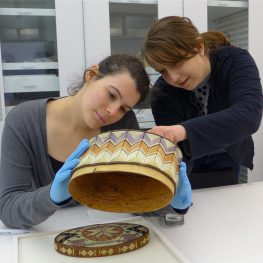Lady Franklyn’s Quilled Mi’kmaq Box
By: Margaret Bruchac and Leana Reich
In 1912, the Penn Museum purchased a birch bark box (object number NA 3851) decorated with intricate quillwork from British collector and antiquities dealer William Ockleford Oldman. During the late 1800s to the early 1900s, Oldman sold thousands of ethnographic materials to private collectors and museums (including the British Museum and Museum of the American […]
Investigating a Pipe Tomahawk
By: Margaret Bruchac and Kayla A. Holmes
How does a tomahawk, as an object typically associated with violence, come to be connected to a smoking pipe used in rituals and ceremonies associated with peace? Who devised the idea of welding these different objects together to bring pipe tomahawks into being, and what are the cultural significances surrounding their presence? File these […]
Moose Hair Embroidered Birchbark Trays: French, Native, or Both
By: Margaret Bruchac and Liliana Gurry
The intricate detailing on these birchbark trays was the first thing that caught my eye. It is difficult to fathom the amount of labor and intensive effort it takes to embroider such complex designs into a thin piece of wood. As seen in the images below, these three trays differ in shape, size, and content, […]
The Salmon Basket & Cannery Label
By: Margaret Bruchac and Erica Dienes
This salmon basket from the land of the Tlingit and Yakutat people is a useful piece of art, woven from spruce root, grass, and maidenhair fern in a twined fashion, and originally made to carry lightweight materials. It shows minimal evidence of wear. In size and shape and weaving patterns, it closely resembles other baskets […]
The Kaskasian Beaver Bowl
By: Margaret Bruchac and Ben Kelser
This bowl, in the form of a wooden beaver with a bowl-shaped carving sculpted into its back, is identified as having been crafted by the Kaskaskian people in the Illinois Territory.[1] The bowl was one of two non-identical beaver bowls collected in 1795 by George Turner, who was then serving as a judge in the […]
A Fine Line Between Town and Country
By: Anne Tiballi and Alex Chen
Hello from China! My name is Alex and I’ve just completed my first year in the cultural anthropology PhD program. I am conducting fieldwork in southeast China currently, where I am working with a social enterprise that conducts social impact trip for Chinese high school students hoping to attend college in the US or UK. […]
Coins for Moo: A Cosa Story
By: Anne Tiballi and Jordan Rogers
Cosa has been featured a half-dozen times in the Summer Fieldwork blogs over the past few years. Penn has sent a sizeable contingent of archaeologists, historians, and philologists to the site to participate in the excavation of the bath complex at the Mid-Republican colonial site in Central Italy. The mere existence of the Bath Complex […]
Getting Comfortable with Discomfort
By: Anne Tiballi and Samantha Seyler
As a second year PhD student in Anthropology about to enter my third and final year of coursework, I was nervous as I planned my summer. I had spent the last year researching the history of the region surrounding the town of Comas on the eastern slopes of the central Peruvian Andes. And I had […]
Looted Landscapes of Upper Egypt
By: Anne Tiballi and Robert Vigar
As a graduate student, my research focus has been on the interaction between local communities and cultural heritage in Upper Egypt. One of the things I am keen to understand is the unauthorized exploitation of archaeological sites, what we often hear referred to as looting. What are the socio-economic, cultural, and historical factors that stimulate […]
A Day in the Field
By: Anne Tiballi and Justin Reamer
This summer, with funding from the Penn Museum, I served as a field supervisor and teaching assistant at the Smith Creek Archaeological Project (SCAP) run by Dr. Megan Kassabaum (Assistant Professor of Anthropology, Weingarten Assistant Curator for North America) in Wilkinson County, Mississippi. As a field supervisor, my daily duties consisted of supervising students digging […]










